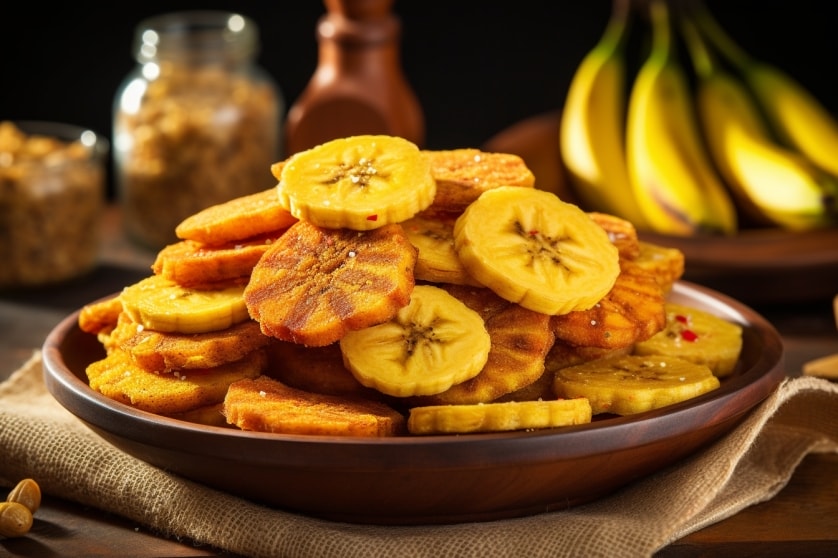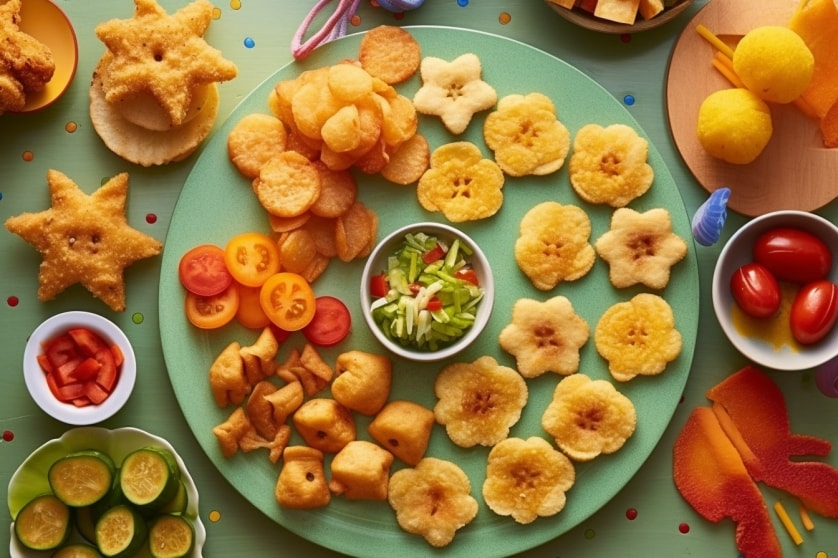Table of Contents
ToggleCuban Tostones for Babies: A Fried Plantain Snack
Introduction:
Picture this: your little munchkin sitting in their high chair, wide-eyed and eager, as you bring forth a plate of crispy, golden delights. Their tiny fingers reach out, grasping a piece of tantalizing Tostone, and their face lights up with pure delight as they take their first crunchy bite. Oh, the joy! Today, we embark on a flavorful journey to the heart of the Caribbean, where we unlock the secrets of Cuban cuisine and dive headfirst into the world of Tostones for babies!
Now, I must warn you, dear reader, that once you introduce your little one to the addictive crunch of Tostones, there’s no turning back. They’ll be hooked, and you’ll find yourself making these delectable morsels on repeat, all while secretly stealing a few for yourself. But fret not, for these delightful bites not only satisfy their taste buds but also offer a wealth of nutritional benefits that will make you feel like the superhero parent you truly are.
So, come along as we embark on a culinary adventure, infusing a dash of Caribbean flair into your baby’s taste buds. Get ready to tantalize their senses, expand their palates, and create lasting memories with every crispy bite of Cuban Tostones!
- Discover the Rich Culinary Traditions of Cuba
- Highlight the Importance of Plantains in Cuban Cuisine
- Discuss the Cultural Significance of Tostones in Cuban Cooking

Section 1: Exploring the Cuban Culinary Heritage
Welcome to the vibrant world of Cuban cuisine, where every dish is a celebration of flavors and a testament to the island’s rich cultural heritage. Prepare to be transported to sun-drenched streets, lively music, and the tantalizing aromas that waft through the air. Cuban cuisine is a vibrant fusion of indigenous, African, and Spanish influences, resulting in a tantalizing medley of tastes that will make your taste buds dance with joy.
At the heart of Cuban cooking lies the mighty plantain, a versatile fruit that steals the show with its myriad of delicious possibilities. Plantains are to Cuban cuisine what sunshine is to a tropical island – essential and ever-present. These starchy beauties are a staple ingredient in countless traditional dishes, adding depth, texture, and a touch of sweetness that makes Cuban food truly irresistible.
You may be wondering, what makes plantains so special? Well, let me tell you, dear reader, these magical fruits are not only packed with flavor but also boast an impressive nutritional profile. They are rich in dietary fiber, which aids in digestion and promotes a healthy gut. Plantains are also an excellent source of potassium, a mineral that supports heart health and helps maintain proper blood pressure levels. And let’s not forget about their vitamin C content, which helps boost your little one’s immune system and keep them protected from sneaky germs.
Now, let’s talk about Tostones, the crispy stars of the Cuban culinary scene. These golden delights are made from green plantains, which are harvested before they have a chance to ripen and develop their characteristic sweetness. Tostones are created by slicing the plantains, frying them to perfection, smashing them flat, and then frying them once again until they achieve a delightful crispness. The result? A symphony of textures – crispy on the outside, tender on the inside, and downright addictive.
But Tostones are more than just a tasty snack. They hold a special place in Cuban culture, symbolizing the joy of gathering around the table with loved ones and savoring the simple pleasures of life. From family gatherings to street food vendors, Tostones bring people together, igniting conversations, and creating memories that last a lifetime. It’s a humble dish that carries the weight of tradition, connecting generations and preserving the flavors of the past.
So, as you embark on this culinary adventure with your little one, remember that you’re not just feeding their tiny tummies; you’re immersing them in a rich tapestry of flavors and culture. Through Tostones, you’re passing down a piece of Cuban heritage, teaching them to appreciate diverse cuisines and embrace the joy of exploring new tastes. So put on your apron, channel your inner Cuban abuela, and get ready to create a culinary masterpiece that will leave your baby craving for more!

Section 2: Interesting Facts about Tostones
Ah, Tostones! These little wonders of the culinary world have a fascinating story to tell. Let me take you on a journey through time and unveil some captivating facts about these beloved fried plantain snacks that will leave you hungry for more knowledge.
Did you know that Tostones have roots that reach back to Africa and the Caribbean? Yes, dear reader, these crispy delights have a history as colorful as their golden hue. It all began with the African slaves who were brought to the Caribbean centuries ago. They brought with them the culinary tradition of frying plantains, which eventually found its way to the shores of Cuba. Over time, Tostones became deeply embedded in the fabric of Cuban cuisine, captivating taste buds and igniting a love affair that continues to this day.
But let’s not just savor the history; let’s dive into the mouthwatering nutritional benefits of Tostones for your precious little one. These delectable treats offer more than just a burst of flavor; they pack a nutritious punch that will make you do a happy dance in the kitchen. Tostones are a fantastic source of dietary fiber, which helps keep your baby’s digestive system running smoothly and promotes a healthy gut. They also provide a good dose of potassium, a mineral that supports heart health and helps maintain proper blood pressure levels. And if that wasn’t enough, Tostones contain vitamin C, which boosts your baby’s immune system and keeps those pesky germs at bay. It’s a win-win situation for both taste buds and health!
Now, let’s talk about the star of the show: the plantain. These magnificent fruits are a close cousin of the banana, but don’t be fooled by their similarities. Plantains are a little less sweet and a whole lot starchier, making them perfect for frying into crispy delights. They come in two main stages of ripeness: green and yellow. Green plantains are used for Tostones, as their firm texture and mild flavor lend themselves beautifully to the frying process. As the plantains ripen and turn yellow, they become sweeter and are used in other delicious dishes. It’s like a culinary transformation that takes place right before our eyes!
It’s also worth noting that Tostones are a snack that can be enjoyed by babies of different ages and stages. For younger babies who are just starting their solid food journey, you can modify the texture of Tostones to make them more manageable. Opt for thinner slices or bite-sized pieces that are easier for tiny hands to hold and munch on. As your baby grows and develops their fine motor skills, you can gradually introduce larger pieces or even Tostone wedges for a more satisfying crunch. It’s all about adapting to their needs and celebrating every milestone along the way.
Before I conclude this fascinating exploration of Tostones, let me tantalize your taste buds with one last intriguing fact. Tostones are incredibly versatile when it comes to seasonings and dipping sauces. You can sprinkle them with a pinch of sea salt for a classic savory twist, or get adventurous with spices like paprika, garlic powder, or even a touch of cayenne pepper for a kick of heat. And when it comes to dipping sauces, the options are endless. From homemade tomato salsa to creamy avocado dip, there’s a flavor combination to suit every palate. So go ahead, get creative, and let your little one’s taste buds embark on a flavor adventure they’ll never forget!

Section 3: Preparing Tostones for Your Little One
Get ready to don your culinary superhero cape because it’s time to dive into the marvelous world of Tostone preparation for your little munchkin! But before we embark on this crunchy adventure, let’s talk about safety first. We want to ensure a secure and joyful cooking experience for you and your baby, so let’s go over some essential tips to keep in mind when handling hot oil.
First and foremost, temperature control is key. You want the oil to reach a temperature of around 350°F (175°C) for frying the plantains. Using a thermometer is a nifty trick to ensure your oil is just right. And here’s a little secret: if you don’t have a thermometer, you can always do a visual test. Drop a small piece of plantain into the oil, and if it sizzles and starts to turn golden within a few seconds, you’re good to go! But remember, dear reader, never leave hot oil unattended, especially when little ones are around. Safety always comes first in our culinary escapades.
Speaking of safety, let’s move on to kitchen equipment. When preparing Tostones, it’s essential to have the right tools at your disposal. A sturdy frying pan or deep skillet is your trusty sidekick in this adventure. Make sure it has high sides to prevent any oil splatters, and choose a size that accommodates your plantain slices comfortably. And here’s a pro tip: if you have a cast-iron skillet, that’s even better! It retains heat like a boss and gives your Tostones that perfect crispy finish.
Now, let’s get down to the nitty-gritty of selecting the star of our show: the plantain. When choosing plantains for Tostones, you want to find the sweet spot between green and yellow. Green plantains are firm and starchy, ideal for achieving that coveted crispiness. Avoid plantains that are completely green or completely yellow, as they won’t yield the same texture and flavor. Look for plantains that have a slightly yellow tinge or some black spots, indicating that they are ripe but still firm enough for frying. It’s all about finding that perfect balance, dear reader.
Now, let’s roll up our sleeves and prepare those plantains for their magical transformation into Tostones. Start by peeling off the tough outer skin of the plantain. You can make a shallow cut along the length of the fruit, then gently lift and peel away the skin. Once your plantain is naked and ready, it’s time to slice it into even pieces. Aim for slices that are about half an inch thick (1.3 cm). Pro tip: a sharp knife makes all the difference in achieving smooth and even slices. Safety first, though! Keep those fingers tucked away while you slice away.
With your plantain slices ready, it’s time to fire up the stove and fry these babies to perfection. Heat your chosen oil in the skillet over medium-high heat until it reaches the desired temperature we talked about earlier. Now, gently place the plantain slices into the hot oil, making sure not to overcrowd the pan. Fry them for a few minutes on each side until they turn a lovely golden brown. You’re looking for that crispy exterior and a tender interior that will make your baby’s taste buds dance with joy.
Once your plantains are fried to golden perfection, it’s time for the smashing finale! Take a sturdy kitchen tool, such as the bottom of a glass or a specialized tostonera (if you have one), and gently press down on each plantain slice to flatten it. Don’t be afraid to put a little muscle into it! This step helps create that delightful texture we all love in Tostones. Now, it’s back into the hot oil for a second fry. Cook them for another few minutes on each side until they become wonderfully crispy and irresistible.
Finally, remove your Tostones from the oil and let them rest on a paper towel-lined plate to absorb any excess oil. It’s essential to let them cool down for a few minutes before serving them to your little one. And here’s where the fun begins! Watch their eyes light up as you present them with these crispy wonders. You can serve Tostones as a standalone snack or pair them with a variety of delicious dipping sauces. From tangy tomato salsa to creamy guacamole or even a yogurt-based dip, the choice is yours. Get creative and let your baby explore different flavors and textures.
And there you have it, dear reader – a step-by-step guide to preparing Tostones for your little one. It’s a journey filled with excitement, flavors, and a whole lot of crunch. So gather your ingredients, unleash your inner chef, and get ready to create a culinary masterpiece that will leave your baby begging for more. Happy cooking!

Section 4: Baby-Friendly Tostones Preparation
It’s time to put on our baby food superhero capes and dive into the world of baby-friendly Tostones! These crispy delights are not only a treat for grown-ups but can also be a fantastic addition to your little one’s culinary journey. So let’s get started and explore some tips and tricks to make Tostones baby-friendly without compromising on taste or texture.
The first step in creating baby-friendly Tostones is to consider the texture. For younger babies who are just starting their solid food adventure, it’s essential to ensure a smooth and manageable texture. To achieve this, you can opt for thinner slices of plantains or even mash the Tostones after they have been fried for the second time. This will create a soft and easily mashable consistency that is perfect for little gums and developing palates.
As your baby grows and becomes more comfortable with chewing, you can gradually introduce larger pieces of Tostones. This will allow them to practice their chewing and develop their oral motor skills. You can also experiment with different shapes, such as bite-sized squares or even Tostone wedges, to make it easier for your little one to hold and explore on their own. Remember, dear reader, it’s all about adapting to your baby’s developmental stage and celebrating their milestones along the way.
Now, let’s talk about flavors. While Tostones are delicious on their own, you can also incorporate various baby-friendly seasonings to enhance the taste and introduce your little one to new flavors. Keep it simple at first with a pinch of mild sea salt or even a sprinkle of cinnamon for a touch of sweetness. As your baby becomes more adventurous, you can experiment with other spices and herbs, such as garlic powder, paprika, or even a hint of turmeric. Just be mindful of their taste preferences and any potential allergies or sensitivities.
Another fantastic aspect of baby-friendly Tostones is their versatility. You can pair them with a wide array of nutritious toppings and dipping sauces to create a well-rounded meal or snack for your little one. How about a dollop of homemade avocado mash for some healthy fats and creamy goodness? Or perhaps a smear of hummus for added protein and a burst of flavor? You can even serve Tostones alongside cooked vegetables or a protein source, such as shredded chicken or beans, to create a balanced meal that will delight your baby’s taste buds.
When it comes to introducing Tostones to your baby, it’s essential to keep an eye on any potential allergies or reactions. If it’s their first encounter with plantains, it’s recommended to introduce them alongside other foods that have already been successfully introduced to your baby’s diet. This will help you monitor any potential adverse reactions and ensure their safety and well-being. Remember, dear reader, every baby is unique, and it’s important to listen to their cues and consult with your pediatrician if you have any concerns.
Lastly, let’s not forget the joy of sharing this culinary adventure with your little one. Get them involved in the process by letting them explore the texture and flavors of the Tostones. Allow them to use their tiny fingers to pick up the bite-sized pieces, encouraging self-feeding and sensory exploration. It’s not just about the food; it’s about creating positive associations with mealtime, fostering independence, and nurturing a love for wholesome, homemade goodness.
So there you have it, dear reader – a guide to preparing baby-friendly Tostones that will delight your little one’s taste buds and contribute to their culinary exploration. Remember to adapt the texture and flavors to suit your baby’s developmental stage and preferences. Embrace the mess, celebrate the milestones, and savor these precious moments of shared joy. Happy cooking and happy eating!

Section 5: Tostones Recipe for Babies
Brace yourself, dear reader, because we’re about to embark on a flavor-packed journey with a simple yet scrumptious Tostones recipe tailor-made for your little one’s taste buds. Get ready to savor the crispy goodness and watch your baby’s face light up with every bite. Let’s dive right in!
Ingredients:
- 1 green plantain
- Coconut oil (or oil of your choice) for frying
- A pinch of mild sea salt (optional)
Recipe Steps:
- Start by peeling the green plantain. Make a shallow cut along the length of the fruit, then gently lift and peel away the tough outer skin. Safety first, dear reader! Keep those fingers tucked away while you peel.
- Once your plantain is naked and ready, slice it into even pieces, about half an inch thick (1.3 cm). A sharp knife works wonders in achieving smooth and uniform slices. Safety first, though! Watch those precious fingers.
- Heat coconut oil (or your chosen oil) in a frying pan or deep skillet over medium-high heat. Aim for a temperature of around 350°F (175°C). Remember our little secret from before? If you don’t have a thermometer, drop a small piece of plantain into the oil. If it sizzles and starts to turn golden within a few seconds, you’re good to go!
- Carefully place the plantain slices into the hot oil, making sure not to overcrowd the pan. Fry them for a few minutes on each side until they turn a lovely golden brown. You’re looking for that perfect crispiness that will make your baby’s taste buds do a happy dance.
- Once the plantains are fried to perfection, remove them from the oil and let them rest on a paper towel-lined plate to absorb any excess oil. Safety alert: they will be hot, so resist the temptation to taste-test right away. Patience, dear reader!
- It’s time for the smashing finale! Take a sturdy kitchen tool, such as the bottom of a glass or a specialized tostonera if you have one, and gently press down on each plantain slice to flatten it. Don’t be shy! Give it a good squish. This step helps create that delightful texture we all love in Tostones.
- Now, return the flattened plantains to the hot oil for a second fry. Cook them for another few minutes on each side until they become beautifully crispy and irresistible. Oh, the anticipation!
- Once your baby’s Tostones are fried to golden perfection, remove them from the oil and let them cool down for a few minutes. We know it’s tempting to devour them right away, but safety and patience are essential, especially when it comes to little taste buds.
- And voila! Your baby-friendly Tostones are ready to be enjoyed. If you’d like, you can sprinkle a pinch of mild sea salt on top for added flavor, but remember to keep it in moderation, especially for younger babies. Now, gather your little one, sit back, and savor this delightful culinary creation together.
There you have it, dear reader – a simple and mouthwatering Tostones recipe for your little foodie. Get ready to be amazed by their reaction as they discover the crispy wonders of this Caribbean delight. So put on your apron, unleash your inner chef, and let the Tostones magic unfold. Happy cooking and happy munching!
Conclusion
And there you have it, dear reader – a flavorful journey through the world of Cuban Tostones for babies. We’ve explored the rich culinary heritage of Cuba, discovered fascinating facts about Tostones, learned how to prepare them for our little ones, and even dived into a baby-friendly recipe. It’s been quite a ride, hasn’t it?
As you embark on this culinary adventure with your baby, remember that food is not just about nourishment; it’s a gateway to exploration, bonding, and creating lasting memories. Through Tostones, you’re introducing your little one to new flavors, textures, and cultures, all while stimulating their taste buds and expanding their palate.
The beauty of homemade baby food lies in the joy of knowing exactly what goes into your baby’s tiny tummy. By preparing Tostones at home, you have the power to choose high-quality ingredients, customize flavors, and adapt the recipe to suit your baby’s individual needs. It’s a labor of love, dear reader, and one that will pay off in the form of happy, healthy little eaters.
As you embark on this culinary journey, don’t forget to have fun! Embrace the mess, savor the shared meals, and celebrate the milestones along the way. Cooking for your baby is an opportunity to unleash your creativity, experiment with flavors, and nourish their growing bodies and minds. So put on that apron, gather your ingredients, and let your kitchen transform into a haven of culinary delights.
Lastly, dear reader, always remember that each baby is unique. They have their own preferences, developmental stages, and individual needs. So be flexible, listen to your baby’s cues, and trust your instincts. If something doesn’t go according to plan, don’t worry. Embrace the journey, adapt as needed, and keep exploring new culinary horizons with your little one.
We hope this guide has inspired you to embark on a Tostones adventure with your baby. May your kitchen be filled with laughter, delicious aromas, and the joy of shared meals. Cheers to raising happy, healthy eaters who appreciate the beauty of homemade goodness. Bon appétit!
Want to take your knowledge to the next level? Check out these must-read articles:
- Jamaican Festival for Babies: A Sweet Cornmeal Dumpling
- Jamaican Ginger Beer for Babies: A Spicy and Refreshing Drink
Organize your baby’s wardrobe with our baby clothes closet organizer products! Our organizers are designed specifically for baby clothes. Get your baby’s clothes neat and tidy with our selection of organizers – shop now!
- DIY Baby Food: Equipment-Free Approaches - October 1, 2025
- Iron-Rich First Foods: Preventing Common Deficiencies - September 30, 2025
- Introducing Potential Allergens: Latest Medical Guidelines - September 24, 2025



